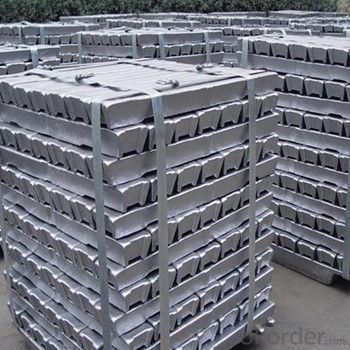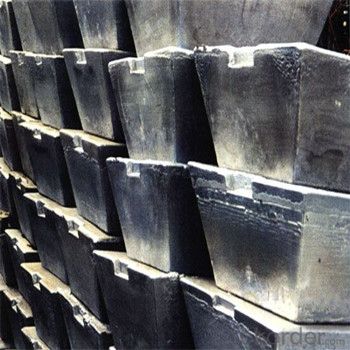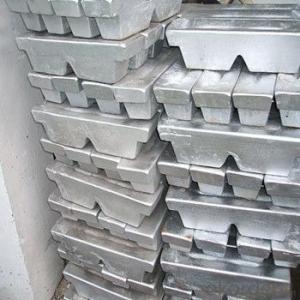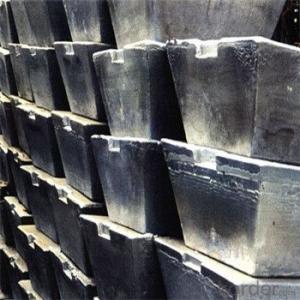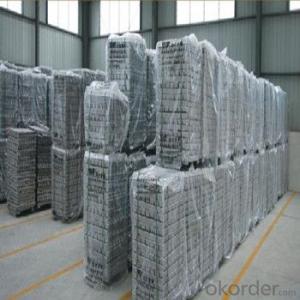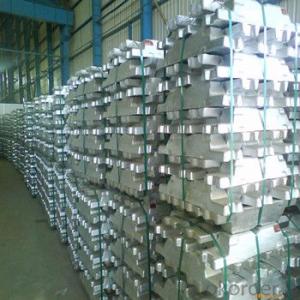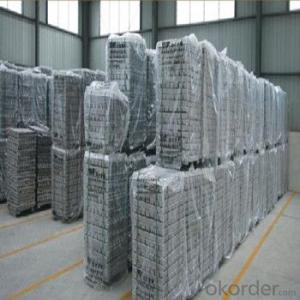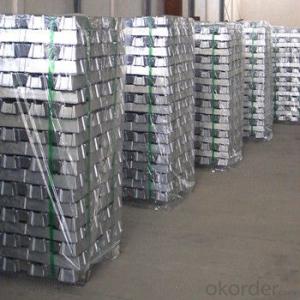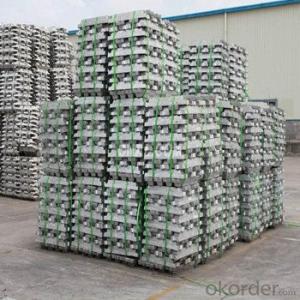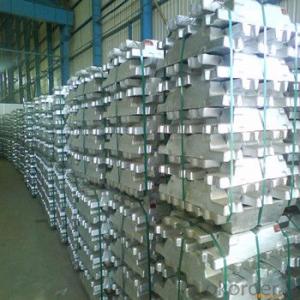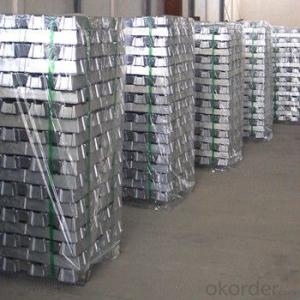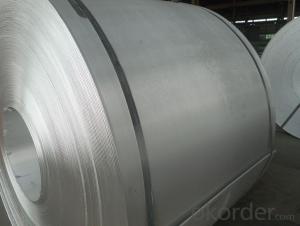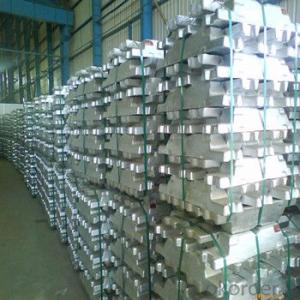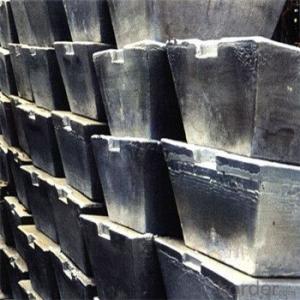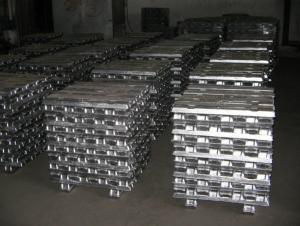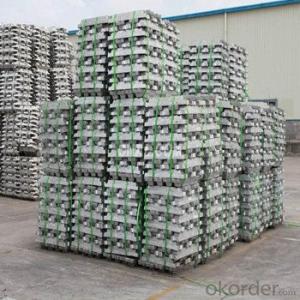Aluminum Pig/Ingot With Mills From China
- Loading Port:
- China main port
- Payment Terms:
- TT OR LC
- Min Order Qty:
- 1000 m.t.
- Supply Capability:
- 100000 m.t./month
OKorder Service Pledge
OKorder Financial Service
You Might Also Like
Pure Aluminum Pig/Ingot Used for Industry
1.Structure of Aluminum Pig/Ingot
A material that has been cast into a shape in order to be transported and processed easier than in an unprocessed form. An ingot is typically rectangular in shape, which allows it to be stacked. Ingots are most commonly associated with metals, with ingots of gold held in the vaults of banks and brokerages being popular images.
Aluminum Ingot is with the AL as the main chemical composition.Aluminum Ingot is used for industry,such as automobile,pinning and weaving,electron broadly and so on. Aluminum Ingot has the following advantages: easy control and operation, fast melting.
2.Main Features of the Aluminum Pig/Ingot
•High Purity
•Easy control and operation
•High strength
•Fast melting
•Competitive price
•Best Service
3.Aluminum Pig/Ingot Images
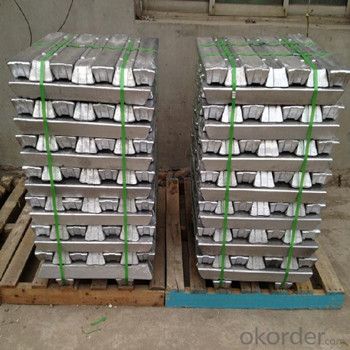
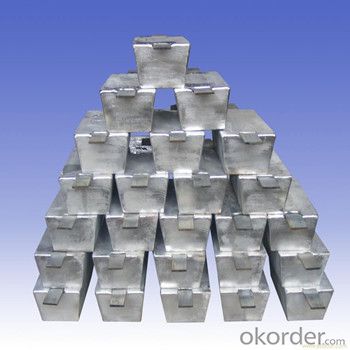
4.Aluminum Pig/Ingot Specification
Grade | Chemical Composition % | |||||||||
Al≥ | impurities ≤ | |||||||||
Si | Fe | Cu | Ga | Mg | Zn | Mn | others | Sum | ||
Al99.9 | 99.90 | 0.50 | 0.07 | 0.005 | 0.02 | 0.01 | 0.025 | - | 0.010 | 0.10 |
Al99.85 | 99.85 | 0.80 | 0.12 | 0.005 | 0.03 | 0.02 | 0.030 | - | 0.015 | 0.15 |
Al99.7 | 99.70 | 0.10 | 0.20 | 0.010 | 0.03 | 0.02 | 0.030 | - | 0.030 | 0.30 |
Al99.6 | 99.60 | 0.16 | 0.25 | 0.010 | 0.03 | 0.03 | 0.030 | - | 0.030 | 0.40 |
Al99.5 | 99.50 | 0.22 | 0.30 | 0.020 | 0.03 | 0.05 | 0.050 | - | 0.030 | 0.50 |
Al99.00 | 99.00 | 0.42 | 0.50 | 0.020 | 0.03 | 0.05 | 0.050 | - | 0.050 | 1.00 |
5.FAQ of Aluminum Pig/Ingot
We have organized several common questions for our clients,may help you sincerely:
①How about your company?
A reliable manufacturer & supplier of Aluminum Pig/Ingot,with many years’ experience in producing Aluminum Pig/Ingot.The items have beedn exported around the world,and have been acceptable among the customers,and have gotten the good reputation already.No matter from the quality,price and service,can be guaranteed for the cusgtomers.High purity and diffent grade are available.
②How to guarantee the quality of the products?
We have established the international advanced quality management system,every link from raw material to final product we have strict quality test;We resolutely put an end to unqualified products flowing into the market. At the same time, we will provide necessary follow-up service assurance.
③How long can we receive the product after purchase?
In the purchase of product within three wo We have organized several common questions for our clients,may help you sincerely:
- Q: Can aluminum ingots corrode?
- Indeed, it is possible for aluminum ingots to experience corrosion. Despite being renowned for its resistance to corrosion, aluminum is not entirely impervious to it. When subjected to specific environments, like those containing high salt or acid concentrations, aluminum can undergo a process known as oxidation. This process gives rise to the formation of a thin layer of aluminum oxide on the surface of the metal, which serves as a safeguard, preventing further corrosion. Nonetheless, if this protective layer becomes damaged or compromised, the underlying aluminum can become vulnerable to corrosive elements, ultimately resulting in corrosion. Consequently, although aluminum ingots generally display resistance to corrosion, it is crucial to exercise proper caution and take necessary measures to shield them in corrosive surroundings.
- Q: Now refining aluminum ingot profits? What are the main factories?
- As far as I know, without such special equipment, the national general practice is to use small furnace crucible to produce, products produced in the industry is commonly known as "coke ingot.".
- Q: How are aluminum ingots used in the production of bicycles?
- Aluminum ingots play a crucial role in the production of bicycles as they are the primary material used to manufacture bicycle frames. Aluminum is a lightweight and durable metal, making it ideal for creating strong yet lightweight frames. To produce bicycle frames, aluminum ingots are first melted down and then poured into molds to form the desired shape. The molten aluminum is allowed to cool and solidify, resulting in a solid ingot in the shape of the frame. These aluminum ingots are then further processed through various techniques such as extrusion or hydroforming to shape them into tubes or other desired forms. The tubes are cut, welded, and joined together to create the frame structure of the bicycle. Aluminum ingots are preferred in bicycle manufacturing due to their exceptional strength-to-weight ratio. This allows for a lighter bicycle that is easy to handle and maneuver, while still providing the necessary strength and rigidity for support. Additionally, aluminum ingots offer excellent corrosion resistance, ensuring that the bicycle frames can withstand harsh weather conditions and last for a longer period. This feature is especially important for bicycles as they are often exposed to outdoor elements. Furthermore, aluminum ingots enable manufacturers to create frames with intricate designs and shapes, providing opportunities for customization and innovation in bicycle design. In summary, aluminum ingots are integral to the production of bicycles as they are used to create lightweight, durable, and corrosion-resistant frames. Their versatility and strength make them a preferred choice for manufacturers, contributing to the overall quality and performance of bicycles.
- Q: What are the advantages of the CNC process for aluminum and die cast aluminum?
- The main properties, namely strength, hardness and wear resistance, are in accordance with the national standard GB6063. The utility model has the advantages of light weight, only 2.8, no rust, fast design change, low die input and longitudinal elongation up to more than 10 meters. There is light, matte of aluminum processing appearance, the process of anodic oxidation treatment, surface treatment of oxide film thickness reaches 0.12m/m. The wall thickness of aluminum profile is chosen according to the optimization of product design. The thicker the market is, the better the design of sectional structure should be. It can be uneven in 0.5~5mm. Layman thinks that the thicker and tougher, it is the wrong view.
- Q: Could you tell me how to calculate the value of aluminum material? By weight or by length or by other means?
- According to the weight calculation, international trade every day aluminum prices refresh, at this stage in 17 thousand tons, finished to calculate the cost of processing, such as: Aluminum Alloy window, this is an aluminum extrusion, extrusion processing costs to add 4500 tons.
- Q: What does aluminium ingot blacken because of temperature? Rain? Aluminium oxide? Iron salt?
- The humidity is contacted with the air and is oxidized. The aluminum ingot also contains trace amounts of other metal elements, which are also oxidized to black
- Q: What are the different methods for machining aluminum ingots?
- There are several different methods for machining aluminum ingots, including CNC milling, turning, drilling, grinding, and sawing. These methods allow for the precise shaping, cutting, and finishing of aluminum ingots to create various components and products.
- Q: How can I make aluminium ingots for cans?
- You need a basic open hearth is heating aluminum cans, but is not the direct melting aluminum ingot what meaning, that thing in a lot of impurities, but also remove the magnesium, zinc, manganese and other elements, these processes need professional personnel, so difficult to master.
- Q: How are aluminum ingots used in the production of power transmission towers?
- Aluminum ingots are used in the production of power transmission towers as a key material for constructing the tower structure. They are melted and cast into specific shapes to form the tower components, such as the main support columns, cross arms, and braces. Aluminum's lightweight yet strong properties make it an ideal choice for these applications, enabling the towers to efficiently support the transmission lines while minimizing the overall weight and cost of the structure.
- Q: I would like to ask, aluminum water poured into the mold, what should pay attention to? Aluminum solidification in the mold after the aluminum ingot, how can I get it out?
- Cast aluminium is divided into casting and die casting. In general, mold parting agent shall be applied in the mold cavity.
Send your message to us
Aluminum Pig/Ingot With Mills From China
- Loading Port:
- China main port
- Payment Terms:
- TT OR LC
- Min Order Qty:
- 1000 m.t.
- Supply Capability:
- 100000 m.t./month
OKorder Service Pledge
OKorder Financial Service
Similar products
Hot products
Hot Searches




